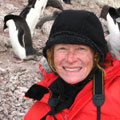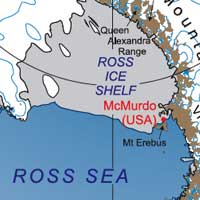Penguins in a Changing Climate
MCMURDO STATION, ANTARCTICA– I’ve made it down to Antarctica for another season of studying how penguins are coping with global climate change. In this video, I introduce the work we are doing and give a preview of what I’ll be reporting on over the next few months. Stay tuned!
Get the Flash Player to see this player.











cute
We are a class in northern Florida, USA that studies the world through technology. We’ve been learning about Antarctica lately, and been following the scientist, Howie Koss. We’d love to know more about penguins however and wondered if you could answer some of our questions.
1. Do penguins allow you to touch them, and if so how do they feel?
2. Do you get a chance to interact with them when you’re not working?
3. When did you start getting interested in studying penguins?
4. If you get bit or scratched by a penguin, do they carry any bacteria that might cause disease or an infection?
5. In the video we saw a mother penguin with two babies. Do they have twins? And if so, how do they care for both eggs?
6. How long do baby penguins get cared for by their parents before they take off on their own?
7. If there are twins, would both be taken care of or would one be abandoned?
8. How long are penguins in their egg before they hatch?
9. If you found an abandoned penguin, would you adopt it or let nature take its course?
10. How long does a penguin generally live, and if it dies early, what usually kills it?
We look forward to your respones. Thanks.
Mrs. Hutchins’s class
The Antarctic is being far less effected than the North Arctic since the Antarctic is a continent and the Artic meaning north pole is frozen glaciers on the ocean surrounded by continents. The warming oceans along with man made abuse has caused the glaciers to be disasterous in the North Pole but in very small degrees in the South Pole, Antarctic. The concern you have is admirable but many scientist will attest that the Penquins are far less headed for extinction than animals of the northern hemisphere. Penquins are bountiful.
Hello Leslie Wetter, I hear what you’re saying but you have to realize that these animals — penguins or polar bears — are in a sense the laboratory test animals that we humans are using in this great experiment we are conducting: filling our atmosphere with greenhouse gases and sitting by to see the result. Because of the reasons you pointed out, yes, the polar bears will be the first to go along with alot of humans currently living in low-lying areas (e.g. Florida, Wall Street and may other coasts). Anything that we can do to now stop the experiment will benefit the bears, and also the penguins…and, yes, the humans.
Unfortunately a couple of penguin species probably won’t be around to exhibit their response to the finish of the climate change experiment. This is because industrial fishing (catching fish used in the US) , in another great experiment (removing the fish from the ocean), has already earned them a place on the Endangered Species List. Five more penguin species, for the same reason, were just added to the list as ‘threatened species’ (not quite on the brink of extinction). For sure, the true Antarctic penguins are now abundant enough that they may see what end to these experiment s there will be that we will be seeing in the not-so-distant future (humans being born this decade will be tallying the results).
So, anyway, unfortunately, we’re all in this experiment together.
Cheers (?), David Ainley
Greetings Mrs Hutchins 6-grade class, sorry for the delay in responding.
1. These penguins do like to be touched and will bite or bash you with their flippers if you get too close, but sometimes we have to catch them to make measurements. They are very tough birds, and the coat of feathers is very dense. It feels like holding a football.
2. Most of the interaction I have with them is to simply watch and observe. They are very animated and have personalities. Lots of drama in the colony with everyone so close to each other, and I never get tired of watching them go out over the sea ice to find food.
3. I have always been interested in birds and my college degree is about birds, but it wasn’t until I came to Antarctica for the first time in 1999 that I really fell in love with penguins.
4. I have been scratched by a penguin, but like any other scratch I just washed it well, there was not infection.
5,7 Adelie Penguins always lay 2 eggs and care for them both.
6. It takes about 50 days from hatching to being on their own. In that time they will multiply their birth weight by 30.
8. The eggs take about 30-35 days to hatch.
9. We can not interfere with nature here, we are only observers.
10. In the wild Adelie Penguins can live to be about 20 years old, probably longer in the zoos where they do not have to worry about getting food or leopard seals, their main predator.